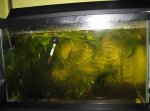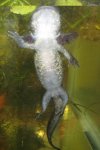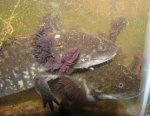caudatadude28
New member
- Joined
- Jun 25, 2008
- Messages
- 794
- Reaction score
- 13
- Points
- 0
- Age
- 31
- Location
- Northern Wisconsin
- Country
- United States
- Display Name
- AJ
Well, today I went herping in a promising spot about an hour away from home. It is a wetland praire with roughly one-hundred ponds in it. It proved successful. I wasn't sure I would find ambystomid larvae in the first few ponds I tried because there were so many ponds. But after about ten minutes of dip netting the edges, it was too deep for me to walk all the way through it, I found an ambystoma tigrinum larvae. I proceeded to dip net it for an hour and I found five ambystoma tigrinum larvae. They are 2-3 inches long. I currently am feeding them earthworms, tadpoles, and some whiteworms. I was wondering if I could feed them feeder guppies or tiny minnows in addition to this. They are in a ten gallon planted tank with a sponge filter. Here are some pics:




And just for fun here are my first three morphs of 12 of my A. maculatum.





And just for fun here are my first three morphs of 12 of my A. maculatum.

















